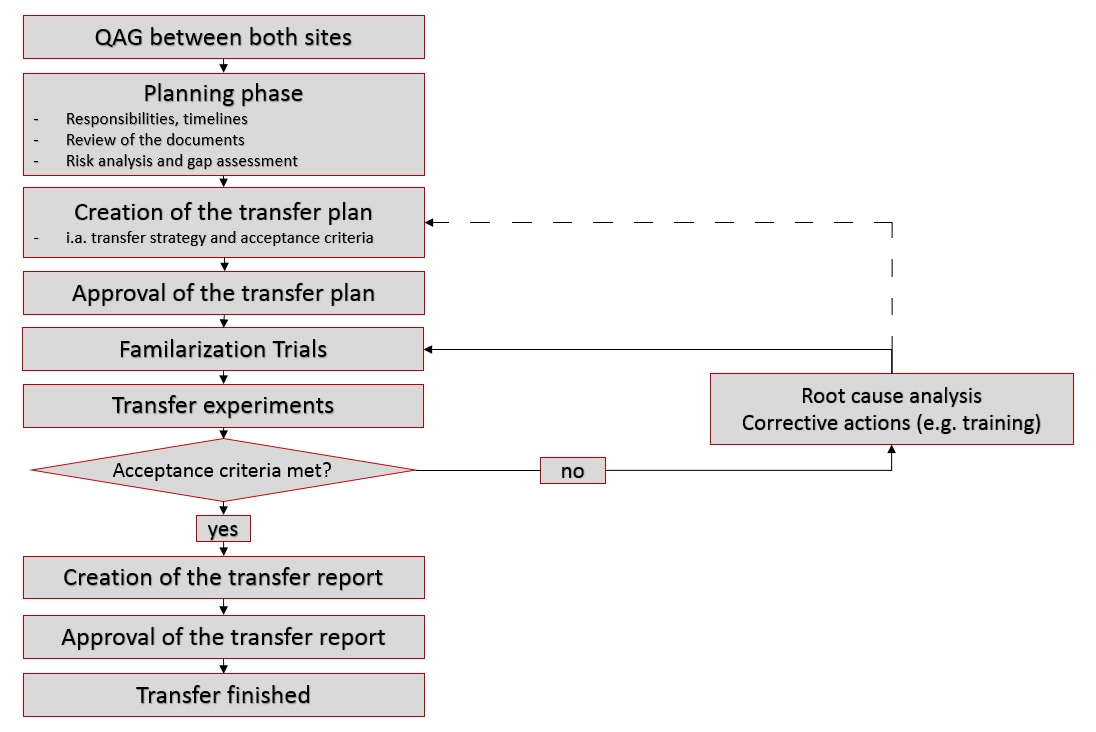Procedure and requirements for method transfers
According to USP <1224> , a transfer of analytical test procedures is a documented process that qualifies the receiving site to use analytical test procedures that have previously been developed by the donor site as intended. The goal of a transfer is to prove that the receiving site is able to perform the transferred methods successfully (that is, accurate and reproducible).
An open and faithful communication between the donor site (DS) and receiving site (RS) is the crucial factor for success, as well as a detailed risk analysis in the beginning. Furthermore, allow enough time for the transfer, because the RS might possibly need to buy and qualify devices and the transfer has to be finished before starting routine measurements.
Method transfers are one aspect in the life cycle of pharmaceuticals and can happen with different complexity:
- 1 single method to one contract laboratory
- Transfer of the whole analytical methods of a product within a technology transfer
- Within a company between different sites
- Between development and QC laboratory
- Between different companies, to a contract manufacturing organization or a contract laboratory
A method transfer should follow a structured procedure. This will be shown in the following figure.

After the quality agreement has been signed by both sites, the planning phase begins, where the responsibilities and the schedule are settled upon. The required documents (among others product specifications, test instruction(s) and the corresponding validation(s), development reports if necessary) are handed over. The difference between the two laboratories are identified and evaluated with a risk analysis and gap assessment. This can be, for example, different equipment, but also the deliberate decision to use the same reagents. The risk analysis is also used to deduce the extent of the transfer activities, the transfer strategy and the acceptance criteria. The following aspects can be considered according to the Aide mémoire of ZLG AiM 07123101:
- the robustness of the method at the DS
- the qualification status of the DS
- whether / to what extent changes (of the method itself, the rooms, equipment, materials, environmental conditions) are planned
- the understanding of the method and the qualification of the RS laboratory staff
- whether the QM systems (such as GMP, GLP or DIN EN ISO 17025) of DS and RS are comparable
USP <1224> focuses on this risk-based approach as well. Regarding the transfer strategy, complexity and criticality of the method, as well as the experience and the capability of the RS have to be taken into account to choose a suitable transfer type (comparative studies, covalidation, complete or partial (re-)validation, transfer waiver).
As a next step, a transfer plan is created. Each site can create a transfer plan, but as a rule it makes more sense if the DS takes on the creation because it has experience with the method. The transfer plan describes all methods that need to be transferred (product release and stability methods, but methods for starting materials, packaging components and cleaning samples as well) as well as the strategy for implementation. Depending on the transfer’s complexity, it can make sense to create a superimposing master transfer plan as well as a transfer protocol (called “analytical method transfer exercise” = AMTE) for the practical part of the transfer separately for each method that’s going to be transferred. The transfer plan should describe – among others – the following contents according to chapter 6 of the EU GMP guideline 6: the reference standards and samples to be used as well as the requirements for transport and storage, the tests to be implemented as well as the corresponding acceptance criteria. Further detailed requirements for the content can be found in USP <1224> and in WHO Guideline 961, Annex 7.
After both sites have approved the transfer plan, the RS familiarizes itself with the method by performing the first trials on its own (= familarization trials). If necessary, the DS trains the staff of the RS. If the RS wishes to fundamentally change the method, the regulatory influence has to be considered.
If the RS is familiar with the performance of the method in question, the transfer experiments are performed like defined in the plan or the AMTE protocols respectively.
If the acceptance criteria are met, the RS creates a final transfer report. There, the methods performed are described and the results summarized. It also points out any particular observations and deviations from the plan and evaluates them. The results are assessed in respect to the acceptance criteria that have been defined beforehand. In a clear conclusion it’s evaluated whether the RS is qualified for the transferred test procedures and can be approved as testing site for the analyses.
If the acceptance criteria can’t be met, the deviation needs to be examined and the root cause identified. Possible root causes can be, for example, the use of reagents from different manufacturers, a different sample preparation, incorrect sample storage or different result calculations. The transfer experiments can only be repeated once corrective actions (for example training, adequate storage) have been taken. The deviations have to be noted and evaluated in the transfer report.
Finally, transfer is finished when both sites sign the transfer report.
